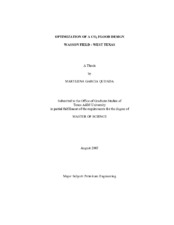| dc.contributor.advisor | Schechter, David | |
| dc.creator | Garcia Quijada, Marylena | |
| dc.date.accessioned | 2006-10-30T23:22:50Z | |
| dc.date.available | 2006-10-30T23:22:50Z | |
| dc.date.created | 2005-08 | |
| dc.date.issued | 2006-10-30 | |
| dc.identifier.uri | https://hdl.handle.net/1969.1/4138 | |
| dc.description.abstract | The Denver Unit of Wasson Field, located in Gaines and Yoakum Counties in west
Texas, produces oil from the San Andres dolomite at a depth of 5,000 ft. Wasson Field is
part of the Permian Basin and is one of the largest petroleum-producing basins in the
United States.
This research used a modeling approach to optimize the existing carbon dioxide (CO2)
flood in section 48 of the Denver Unit by improving the oil sweep efficiency of miscible
CO2 floods and enhancing the conformance control.
A full compositional simulation model using a detailed geologic characterization was
built to optimize the injection pattern of section 48 of Denver Unit. The model is a
quarter of an inverted nine-spot and covers 20 acres in San Andres Formation of Wasson
Field. The Peng-Robinson equation of state (EOS) was chosen to describe the phase
behavior during the CO2 flooding. An existenting geologic description was used to
construct the simulation grid. Simulation layers represent actual flow units and resemble
the large variation of reservoir properties. A 34-year history match was performed to
validate the model. Several sensitivity runs were made to improve the CO2 sweep
efficiency and increase the oil recovery.
During this study I found that the optimum CO2 injection rate for San Andres Formation
in the section 48 of the Denver Unit is approximately 300 res bbl (762 Mscf/D) of
carbon dioxide. Simulation results also indicate that a water-alternating-gas (WAG) ratio
of 1:1 along with an ultimate CO2 slug of 100% hydrocarbon pore volume (HCPV) willallow an incremental oil recovery of 18%. The additional recovery increases to 34% if a
polymer is injected as a conformance control agent during the course of the WAG
process at a ratio of 1:1. According to the results, a pattern reconfiguration change from
the typical Denver Unit inverted nine spot to staggered line drive would represent an
incremental oil recovery of 26%. | en |
| dc.format.extent | 2391560 bytes | en |
| dc.format.medium | electronic | en |
| dc.format.mimetype | application/pdf | |
| dc.language.iso | en_US | |
| dc.publisher | Texas A&M University | |
| dc.subject | CO2 flooding | en |
| dc.title | Optimization of a CO2 flood design Wesson Field - west Texas | en |
| dc.type | Book | en |
| dc.type | Thesis | en |
| thesis.degree.department | Petroleum Engineering | en |
| thesis.degree.discipline | Petroleum Engineering | en |
| thesis.degree.grantor | Texas A&M University | en |
| thesis.degree.name | Master of Science | en |
| thesis.degree.level | Masters | en |
| dc.contributor.committeeMember | Ahr, Wayne M. | |
| dc.contributor.committeeMember | Ayers, Walter B. | |
| dc.type.genre | Electronic Thesis | en |
| dc.type.material | text | en |
| dc.format.digitalOrigin | born digital | en |


